Network Attached Storage (NAS)
Your Private Cloud Solution
NAS devices are designed to handle data storage and file-sharing
requests, providing fast, secure, and reliable services to private
networks.
Before the advent of NAS, organizations had to invest in building, configuring, and managing file servers, a process that was often complex and resource-intensive. NAS technology streamlines this by providing an easy-to-use system with significant storage capacity at a lower cost. Its flexibility and scalability mean storage can be expanded simply by adding more or larger drives, and NAS devices can be clustered to further enhance capacity.
Discover the NAS Benefits
- Scalability: Easily expand storage by adding drives; upgrade without network downtime.
- Enhanced Performance: Direct LAN connection speeds up file storage and access, freeing other devices to improve overall network efficiency.
- Simplified Setup: Minimal installation and configuration needed, reducing IT workload.
- Universal Accessibility: Centralized storage accessible by various devices, supporting collaboration across locations.
- Versatile Expandability: Install apps for added functions like security, backup, and more.
- Cost-Effectiveness: NAS offers an affordable solution to increase storage without significant infrastructure changes.
- Reliability: Designed for continuous operation, NAS systems ensure data is always available.
- Data Protection: Built-in features for backup and recovery safeguard against data loss.
NAS: Simplified Storage and Data Access
Network Attached Storage (NAS) is a dedicated file storage system that simplifies data access for multiple users and devices across a local area network (LAN). By connecting through a standard Ethernet via a router or network switch, NAS offers a centralized storage space, making it an efficient solution for sharing and managing large volumes of data, including unstructured types like documents, videos, audio files, and medical images.
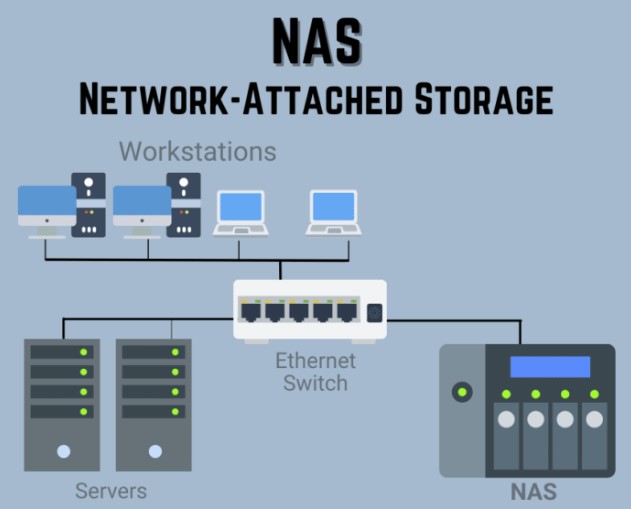
Easy-to-use System
NAS is used in businesses to store and share data within a network. The data stored on the NAS can be accessed easily by users on the same network, allowing for faster collaboration and improved communication among teams.
With the right setup, multiple users can access and edit shared files simultaneously. This makes it easier for organizations to manage their documents, photos, music, videos, and other forms of digital media. Businesses that handle a large amount of data can’t send it daily to their cloud storage. NAS is one type of storage device that helps manage, store, share, and keep all this data secure.
Before the advent of NAS, organizations had to invest in building, configuring, and managing file servers, a process that was often complex and resource-intensive. NAS technology streamlines this by providing an easy-to-use system with significant storage capacity at a lower cost. Its flexibility and scalability mean storage can be expanded simply by adding more or larger drives, and NAS devices can be clustered to further enhance capacity.
Our Partner QNAP - Leading NAS Provider
QNAP (Quality Network Appliance Provider) is devoted to providing comprehensive solutions in software development, hardware design and in-house manufacturing. Focusing on storage, networking and smart video innovations, QNAP now introduce a revolutionary Cloud NAS solution that joins our cutting-edge subscription-based software and diversified service channel ecosystem. QNAP envisions NAS as being more than simple storage and has created a cloud-based networking infrastructure for users to host and develop artificial intelligence analysis, edge computing and data integration on their QNAP solutions.
NAS Solutions
QNAP TS-h2490FU
ZFS-based, 24-bay U.2 NVMe all-flash storage built for high-performance and low-latency virtualized workloads, data centers, and 8K streams

Features
The NVMe all-flash TS-h2490FU is designed for providing extreme performance with high cost-efficiency. Featuring 24 U.2 NVMe Gen 3 x4 SSD bays, the TS-h2490FU delivers up to 661K / 245K random read/write IOPS with ultra-low latency. The ZFS-based QuTS hero operating system supports inline data deduplication and compression for reducing I/O and SSD storage consumption, which significantly extends SSD lifespan with a higher price-performance ratio for all-flash storage arrays. Coupled with near-unlimited snapshots, real-time SnapSync, and petabyte-scale storage expansion capabilities, the TS-h2490FU is ideal for I/O-intensive and latency-sensitive applications, and eliminates productivity bottlenecks in modern data centers, virtualization, and mission-critical backup/restore tasks.
- Optimal SSD performance
Inline data deduplication and compression, Pool Over-provisioning, and TRIM maximize SSD performance and lifespan. - 4 x 25GbE SFP28 ports
Multi-connectivity of 25GbE SFP28 and 2.5GbE RJ45 accelerate virtualization, intensive file access, and large backup/restoration tasks. - 5 x PCIe Gen 4 slots
PCIe Gen 4 slots allow for installing 10GbE/25GbE/40GbE/100GbE adapters, QM2 cards, or Fibre Channel cards to increase application performance. - Virtualization applications
Supports virtualization storage and hosting virtual machines and containerized apps. - Cloud storage gateway
Cloud storage gateways realize hybrid cloud applications by working with the cache space reserved on NAS to ensure low-latency data access to the cloud. - Petabyte-scale storage
Scalable design to grow with your business by connecting SAS 12Gb/s expansion enclosures for up to petabyte-scale storage capacity.
Virtualization Certifications Supported by TS-h29490FU

Build high-performance storage infrastructure for IOPS-demanding applications
Virtualization
Eliminates storage bottlenecks for unstructured data and I/O intensive workloads; ideal for server virtualization and virtual desktop infrastructure (VDI).Data Centers
Delivers ultra-low latency and high IOPS performance, providing response times within microseconds for data centers that host significant business-critical systems and data.Media and Entertainment (M&E) production
Satisfies smooth 4K/8K media streaming and post-production, empowering multimedia workflows with faster data transfer, access, and backup for boosted efficiency.
TS-h2490FU QuTS hero NAS:Featuring U.2 NVMe all-flash arrays and an AMD EPYC 7002 CPU for ZFS system
2nd Gen AMD EPYC™ 7002 series processors; up to 472K/205K random read/write IOPS
Two 2.5GbE ports, five PCIe Gen 4 ports, and pre-installed dual-port 25GbE SFP28 network adapter(s)
ZFS supports inline data deduplication and compression, near-limitless snapshots, and real-time SnapSync
2nd Gen AMD EPYC™ processors and DDR4 ECC memory
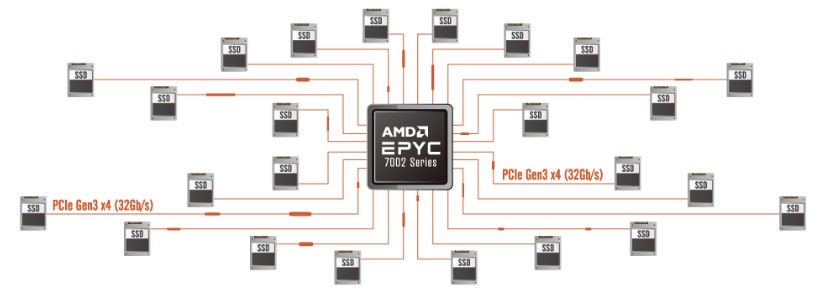
The TS-h2490FU is armed with 2nd Gen AMD EPYC™ 7002 series processors (Rome). Based on the “Zen 2” architecture with cutting-edge 7nm process technology, up to 128 PCIe lanes of I/O are provided for 32Gb/s dedicated bandwidth per SSD. With DDR4 ECC memory that detects and corrects single-bit memory errors for higher reliability, the TS-h2490FU provides 8-channel modules and 16 Long-DIMM slots to fulfill memory-intensive workloads. Demonstrating immense computing power and multi-tasking capabilities, the TS-h2490FU is the ideal choice for uncompromising performance demands in HPC, virtualization, and hybrid/multi-cloud applications.

NAS vs SAN
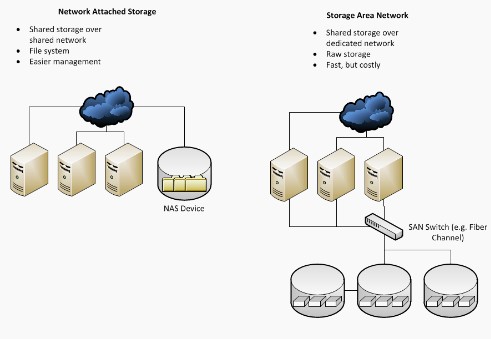
Network Attached Storage (NAS) and Storage Area Network (SAN) are both dedicated storage solutions, but they differ significantly in configuration and use. NAS provides file-level storage through a standard Ethernet connection, making it easy for multiple users and devices to access files over a network. It functions like a private cloud in an office, simplifying data sharing and management. In contrast, SAN offers block-level storage, connecting servers to high-performance disks over a high-speed network typically using Fibre Channel. This setup is ideal for applications requiring high throughput and low latency, such as databases and large-scale virtual environments.
NAS Server
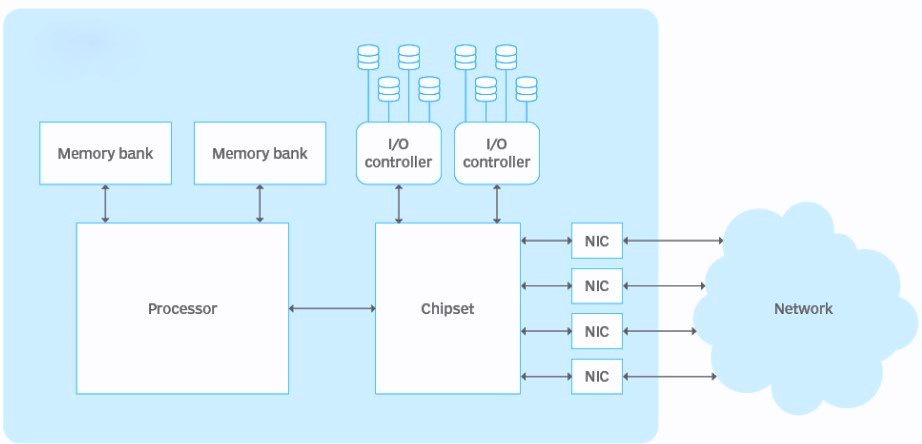
NAS on Site and Cloud NAS compared
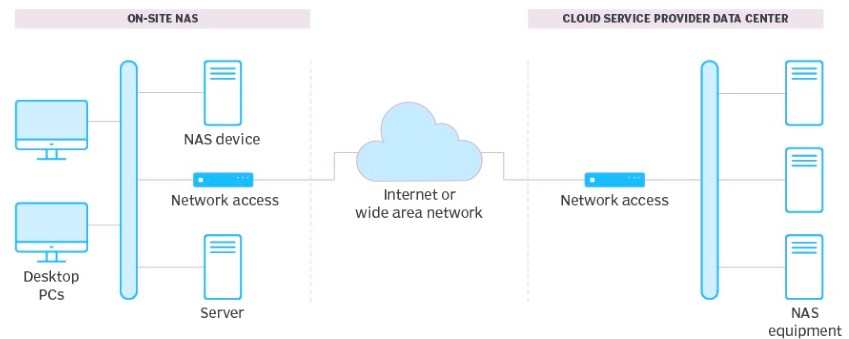




Schrijf in voor onze Nieuwsbrief
Hebt u vragen of hulp nodig? Wij helpen u graag.
